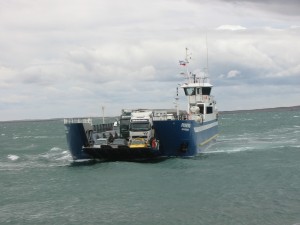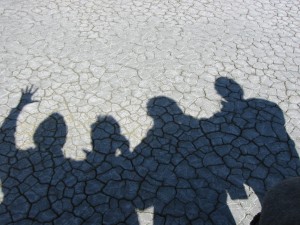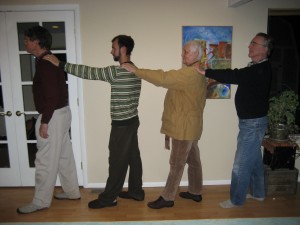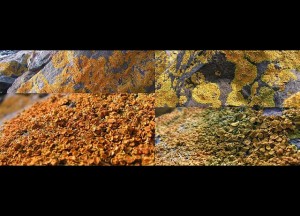Down the E. Coast of Patagonia
My friend Marcelo organized a car trip through Patagonia. As a young guy he had worked on a Patagonian estancia and knew the territory well. The plan was to start in Buenos Aires, drive down the east side of Argentina through the Pampas, along the Atlantic Coast of Patagonia, cross the Strait of Magellan, spend Christmas week with friends in Ushuaia on the island of Tierra Del Fuego, then re-cross the Strait, head west, drive back north along the Andes Cordillera, and then east again to Buenos Aires. 6000 miles. We would be stopping at points of interest, and staying with friends from time to time. What’s there to decide?
In Buenos Aires we had serious negotiations with a rental car manager (“You’re telling me you’re actually planning to take my car through Patagonia?” World-class damage deposit.). We met up with the other two friends making up our little team: Brigette (an Austrian living in Switzerland), and Galina (a Russian living in France). We assembled at the B&B of another friend, Claudia, packed our gear, and then headed south.
Following our plan, we arrived in Puerto Madryn, at the entrance to Peninsula Valdes, where our friend Alex had arranged lodging for us and prepared a wonderful assado, which along with a fine malbec, definitely fortified us for the next leg.
The peninsula is a raw, wild place, jutting far out from the mainland. We saw a number of little herds of guanacos (like llamas), herds of rhea birds (like ostriches), Magellan penguin towns dug in the ground, and ever-bellowing elephant seals. You’ve probably seen videos of killer whales flinging themselves up on a beach, snatching a seal, sort of slithering back into the sea, and then flipping the seal into the air for awhile before devouring it. This peninsula is where that happens.
To reach Ushuaia on schedule, we were going to have to make very good time down the coast. Fortunately the coastal road was paved and in good condition (unlike what we were to find later in Western Patagonia).
Also fortunately, there were three of us who could rotate through the job of driving, and Galina, official trip masseuse, who sat behind the driver’s seat keeping the drivers loose. And always a good supply of the Argentine national drink, mate, being passed around to gently keep us conscious during the long hours of driving at speed.
The wind … As we proceeded south, the wind off the Andes steadily grew. By the time we neared Comodoro Rivadavia, keeping the car on the road was becoming Priority 1 for the driver, and Galina was working overtime.
The highway was fairly straight, so the technique for handling the steady wind was to set the steering wheel about 10 degrees to the right (west), hold it there, and squeegee straight down the road. But occasionally large gusts that had scoured the earth, and bore a hail of sand and pebbles, would broadside us, greatly helping to concentrate the driver’s mind and enhancing the passengers’ excitement. This was strenuous, tiring business, and we wouldn’t have been able to do it at all, if not for the cooperation of our team.
You can be forgiven for thinking that I’m exaggerating. In support, I can only offer you an account in Antoine de Saint-Exupery’s book, Wind, Sand and Stars (Ch 4), in which he describes a wind encounter along this very stretch of coast. He was a mail pilot during the early days, and his route was from Trelew near Puerto Madryn, down to Comodoro Rivadavia.
The wind was so strong that instead of following his southward route, to control his plane at all, he had to turn it to the west, facing the blast from the Andes. OK. But it’s just that at full throttle, he could not move against the wind, and was sometimes blown backwards, out to sea. As he was hovering there, straining to move a few feet forward, he could see the bottom of the ocean because the wind was so strong it had totally flattened out the waves, leaving a glassy plain of water he could look down through.
The plane somehow held together and he was eventually able to maneuver it sideways enough to get into the wind-shadow of a mountain, and gain enough forward speed to make a landing.
See what I mean? Welcome to the winds of Southern Patagonia. This wasn’t going to be our last encounter with them.
Strait of Magellan
After proceeding further south and resting in Rio Gallegos, it was time to cross the Strait of Magellan, to the Chilean side of Tierra del Fuego.
The ride was just what we needed to regain consciousness for the next leg.
The water in the Strait flows from the Atlantic to the Pacific through a narrow channel at 10 times the flow rate of the Amazon River. The tides run as high as 50 feet. And the winds are S. Patagonian winds.
You get across on a ferry. The ferry Captains here are outstanding pilots. The picture shows our ferry, already letting down the ramp while still approaching. There’s no pier. The pilot has to crab it in at a crazy angle and hold it in place with engines & rudder to deal with the ever-changing mix of current, tide and wind, while cars & trucks race off the ramp while they can, and new ones quickly get on board to replace them. Then he’s out of there, heading to Tierra del Fuego (which you can make out in the background). It’s a bracing ride over to The Great Island.
Bump-drafting, San Sebastian Bay Style
Once on Tierra del Fuego, we crossed the border into the Argentine part of the island, and headed for San Sebastian Bay. The bay is on the Atlantic side of the island, and has a very gentle slope that exposes a large plain of mud flats, except at high tide. When we got there, it was a bit breezy, but nothing special.
Marcelo had done the research for his doctorate in geology here, and gave us a good discussion of the natural history of the place as we walked along, picking up large sea shells.
All the while, the wind was picking up. Soon it was gale force, and soon again it was well past that. It was really hard to keep from being blown backwards, let alone move against it. Marcelo said “no problem”, and then showed us a remarkable cooperative strategy for walking into such a wind.
We all know about “slipstreaming” or “drafting”, in which one car follows another closely, staying out of the wind, and letting the front car do all the work.
Nice idea, but if we lined up behind one of our team to shield ourselves from the wind, the lead person still couldn’t move forward. However, if, unlike slipstreaming, we cooperated and added our own walking force to the leader’s, we’d easily have enough power to walk into the wind.
Easy. The arrangement is shown in the photo. The 2nd person puts an arm rigidly on the shoulder of the leader, the 3rd person puts an arm rigidly on the shoulder of the 2nd person – and similarly for the 4th person. Everyone pushes, walking forward in lock step, and the force is transmitted to the lead person, who easily pushes through the wind, and the group moves forward, no problem. Cooperative Strategy, The Great Enabler.
Marcelo claimed that the people of the region use this technique when needed. I don’t know if he was bullshitting me about that or not. He has a great sense of humor, and may have made up the story when he was staying in the little cabin on the Bay while doing his geological research, and waiting for the wind to die down. In any case, it actually works.
Bump-drafting, NASCAR style
The strategy works so well in fact, that the idea is used by NASCAR drivers to increase their speed by enough to cruise right past their competitors in the straight-aways. They call it “bump-drafting”. One car gets behind the other and pushes. Both cars run at full power and reach speeds that neither could individually. Just like people walking into the wind at San Sebastian Bay.
Cooperative Strategies – the Great Enabler
Cooperative strategies tend to get overlooked in favor of competitive ones. Adversarial/competitive strategies tend to punch our buttons more, are more exciting, and much better material for the press. So naturally, we hear about them all the time.
Though less in the news, it’s the mutually enabling character of cooperative strategies, making possible something that isn’t possible for a lone individual, that sets them apart – so much so that effective adversarial strategies almost always contain cooperative substrategies. Team sports, armies, wolf packs, businesses.
The ultimate thing cooperative strategies enable is life itself (which, in turn, enables strategies). There is no organism I can think of that doesn’t pursue a cooperative strategy with some other organism (of its own species or another), at least during some part of its life cycle.
We can think of at least one organism that is constantly dependent in every detail on cooperation.
Lichen species. Lichens have evolved as a combination of algae and fungus, to the extent that neither can ever survive without the other. Like a good team, it has become one thing.
Often imagined independence leads us to think otherwise, but the same is true for humans. Setting aside “me” for a little while, and watching everything one touches or does during the day, it becomes thankfully obvious that, overall, our interdependencies are total, and are remarkably well served.
Not that, like lichen, cooperative strategies are necessarily permanent. Very often they’re tethered to mutual self interest, only until it’s trumped by personal self interest. Think of the cooperation of bicycle racers in a peloton. They alternate taking the brunt of the front and subsequently mutually benefitting from the slipstream created by others. But as the finish line nears, the need to position for winning becomes paramount and the peloton breaks down. Bye bye. It’s been great.
Devising cooperative strategies
The process of devising a cooperative strategy is the same as for any other kind of strategy, except that the external factor of parties becomes central. Between the two or more parties involved in the cooperation, there’s an additional range of available resources and capabilities.
In general, this means potentially more objectives can be entertained, more barriers can be dealt with, more vulnerabilities in the barriers can be attacked with more advantages in the additional resources, and a broader set of exploits can be considered.
The cooperation simply means greater scope for potential strategies. Think about Lt. Thatch, sitting in his kitchen, working through the possibilities of using cooperating pairs of Wildcat fighter planes to create a favorable mismatch with the superior Japanese Zero in dogfights. The synergism inherent in using fighters in pairs, rather than individually, enabled a profoundly effective strategy that turned around the WWII Pacific air war.
So prior to the usual strategy-devising process (simple or complex), the objectives (interests) and contributions of resources/capabilities from multiple parties need to be identified, assessed and agreed on. From then on, devising the strategy is business as usual.
But back to Patagonia …
You may have noticed on a map of S. America that the Andes go on for thousands of miles in a roughly N-S direction, only to curl around to the East through Tierra del Fuego at the southern tip of the continent. We had a beautiful drive over those mountains and through the linga tree forrests, to Ushuaia.
This little city, the southern-most permanent human community in world, sits on the slope of the Andes, where the mountains meet the water. I liked the place a lot, because of the people, the beautiful natural setting – and it’s superb, world-class local beer, Cerveza Beagle (named for the ship carrying Darwin, which called at Ushuaia during its famous voyage).
We had a great time spending the Christmas holiday week with our friends there, before leaving to follow the Andes north, and learning that the easy driving was behind us.
Final thought: let’s close out this post by looking at a video of a cooperative Nebraska barn-moving strategy in action.
______________________________________________________________________________
Readers are encouraged to add comments to this post.
And if you’d like to share or recommend the post, click on your preferred way in the left margin sidebar.
In the next post, the topic will be Found Strategies. Watch for it!
If you’re not currently being automatically notified when new posts are published, then please Follow Real Strategy (top of right hand column on this page), and indicate how you’d prefer to be notified.
For other posts of interest, look in the Smart Menu.
Photo credit: 190 mph Bump Drafting at Taledega, by Brentebeck79. See his photo stream at http://www.flickr.com/photos/44736632@N06/4117831620/
Photo credit: Lichens, by Stuart Anthony. See his photo stream at http://www.flickr.com/photos/stuant63/396901858/












It was fun to watch the Nebraska barn get moved. What a great community project! The carriers will recount their communal success for years.
I also liked the images of the walkers (both the photo and the image in my mind). I am interested that the steps were taken all on the right, then all on the left. For me this was counter-intuitive. In rowing a boat, one needs to row on one side then the other to keep the craft moving toward the intended direction, rather than around in circles. By alternating strokes the boat does not move in a perfectly strait line, but weaves generally in the desired direction. I would have thought that stepping all on the left then all on the right would have made for a similarly weaving line which, while heading generally in the desired direction, would have required a lot of energy to recover from side-to-side movement. I would have thought that instead, every-other person would have stepped on their left, while the people between would have stepped on their right to keep the line from weaving the line dramatically. But perhaps stepping with 1/2 on the right, 1/2 on the left technique actually would have cut the power of each step in half? I’m not sure about this. I guess it’s time for a little field trip to Tierra Del Fuego…
[Translate]
The reason for the lock step is to prevent the person from behind from stepping on the heel of the person in front of them. Just like military marching: left, right; left, right …
[Translate]
I’m loving all of these posts, Bill. This one on Patagonia is most interesting. I think a Cerveza Beagle tee shirt might be the ultimate souveneer from the area! It seems that devising strategies often requires “lateral thinking,” which in turn is fertilized by analyzing problems, looking for hidden elements or assumptions that prevent better insight into solutions. As you have pointed out on occasion, we utilize strategies all the time. But careful dissection and analysis can elevate the game.
[Translate]
David – Yes, unless you’re just lucky, devising a good strategy (one that works well in the world) requires both creative and critical thinking. Both hemispheres and a well-oiled corpus colosum, you might say. The right comes up with, explores and forms possibilities, and the left assesses them, determines problems with them, and feeds them back to the right, asking for rework as required. A lot of back & forth. In the end, the left articulates the strategy when it’s finally formed. The strategy is born in the interchange between the two. When I write about how to devise a strategy, I necessarily present it linearly, but the actual process is distinctly non-linear. Good comment. Glad you’re enjoying the blog.
[Translate]